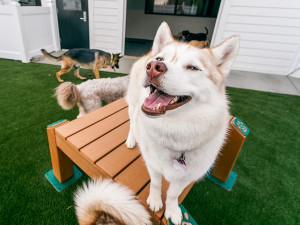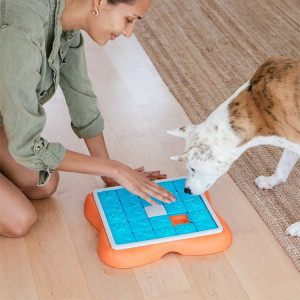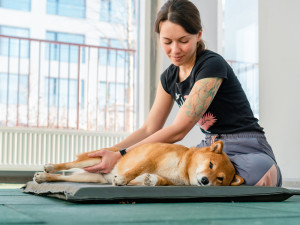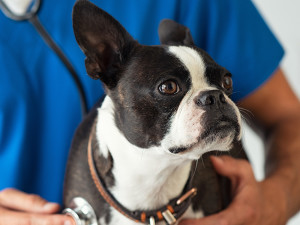How to Train Your Dog For a Day At the Office
Dog trainer Robert Haussmann shares his tips for how to teach your pup to be your favourite co-worker

Share Article
What if every day was Take Your Dog to Work Day? According to recent research on pets in the workplace, morale would be up, stress would be down, and creativity and productivity would be enhanced. With all that upside, who wouldn’t want to take their pup to the office?
But let’s be real. Not all people are well-behaved in the office (looking at you, clips-your-fingernails-at-your-desk guy), so we can’t expect dogs to be perfect, either. Fear not: we checked in with Robert Haussmannopens in new tab – certified dog trainer, co-founder of Dogboy NYCopens in new tab and Kinship Collective member – for advice on setting your dog up for a stellar performance review.
Be realistic about your dog
You know your dog, and you know your office. Before taking your pup to work, try to imagine how they might react in that specific environment. “If you know your dog has issues with other dogs or people, they’re not a good fit for the office. Or maybe your dog is really hyper and always getting into stuff at home. If they can’t be calm at home, they’re going to have a tough time being calm at an office filled with distractions and temptations,” says Haussmann. Also, make sure your pup is rock-solid in the toilet training department. Cute dogs can get away with almost anything – except weeing on your co-worker’s laptop bag.
Teach your pup to chill
While you’re expected to work hard when you’re at the office, your dog’s primary assignment will be to kick back and relax. If your dog’s previous outings have been trips to the park or doggie daycare, they may assume every place they go is meant for fun. That could make for a rude awakening when they get to the office and their human is sitting at a desk ignoring them when all they want (and expect) to do is play. Haussmann recommends getting your dog in the habit of settling down at home before you attempt a trip to the office.
“You want your dog to have rituals around going to a place for quiet time. Get them comfortable taking a nap in a crate, or teach them to do a down/stay by your feet while you’re reading on the couch. Then start introducing more and more stimulus, so they get used to settling when activities are happening around them.” If your dog can stay while you do a yoga class or invite friends over, they’ll stand a better chance of handling the commotion of the office.
Practice real-life scenarios
Basic obedience and socialisation are musts for any future office dog. But they have to be able to apply their skills in the real world, not just during focused training sessions. “Dogs need context,” says Haussmann. “It’s great if your dog can stay when you hold your hand up and walk backward slowly, but that’s not really going to help in an office situation. They need to know ‘settle’ when a delivery person is unloading packages or ‘drop it’ when they retrieve your co-worker’s half-eaten sandwich from the garbage can. And if you have your own office, they need to be comfortable with people passing by or coming into your space.”
To get your dog prepped, simulate likely scenarios before taking them to work. For example, if you’ll need to leave your pup alone for short periods while you attend meetings, tether your dog in one room while you go work in another, so they get comfortable having you out of sight. Or, if you have an open-concept office, try taking your dog to an outdoor café while you catch up on email. That will help them get used to hanging out by your side in a busier environment.
Set your dog up for success in the office
Some dogs may be able to handle having free rein at the office. But most will benefit from being confined – at least until they can be trusted to make good doggie decisions. Keeping your dog on a lead at your desk or in a puppy pen will allow them to see what’s happening around them while also keeping them out of trouble. And make sure they have an assortment of toys, chews or interactive puzzles to keep them occupied throughout the day.
According to Haussmann, “Even a well-trained dog is going to struggle if they haven’t had their energy needs met, or they are under-stimulated.” Help your dog out by exercising them throughout the day and providing plenty of environmental enrichment to keep them from getting bored.
Pay attention to your dog’s body language
Sometimes dogs get overwhelmed by new activities or surroundings, so keep an eye on your dog and look for signs that tell you how they’re feeling throughout the day. “Not all dog body language is obvious,” says Haussmann. “Brush up on common signs of anxiety, fear and aggression. If your dog seems uncomfortable, try to figure out what’s making them feel that way so you can avoid those situations.”
Final words of wisdom
“Don’t over or under think it,” says Haussmann. “Have a plan. Stay calm. And try to see the world from your dog’s perspective.” Lastly, don’t be bummed if your dog isn’t an ideal candidate for office life. Just because they’re not a good fit now doesn’t mean they never will be. Your dog may just need some more socialisation, training or time to mature into the Very Good Pup you know they can be.

Kate Sheofsky
Kate Sheofsky hails from San Francisco, where she developed a love of writing, Giants baseball, and houses she can’t afford. She currently lives in Portland, OR, and works as a freelance writer and content strategist. When not typing away on her laptop, she enjoys tooling around the city with her two rescue pups searching for tasty food and sunny patios.
Related articles
![Dog Looking Away Against Sky]()
Do Hypoallergenic Dogs Really Exist?
Vet Dr Shea Cox separates fact from fiction when it comes to low-shedding breeds
![A dog running with a woman on a pier.]()
8 Questions to Ask Yourself When Choosing a Dog Breed
Find out which dog breed is right for your lifestyle
![Woman with arm tattoos and wearing a black t-shirt stretching out the back legs of a Shiba Inu dog laying on a dark green mat]()
Does Your Dog Need a Massage?
Help your dog stay fit and flexible with these stretch techniques by a certified pet strength and conditioning specialist
![French bulldog being examined at the vet via stethoscope]()
9 Tips For Saving Money At the Vet
Ways to lower your bill – without compromising your pet’s health






